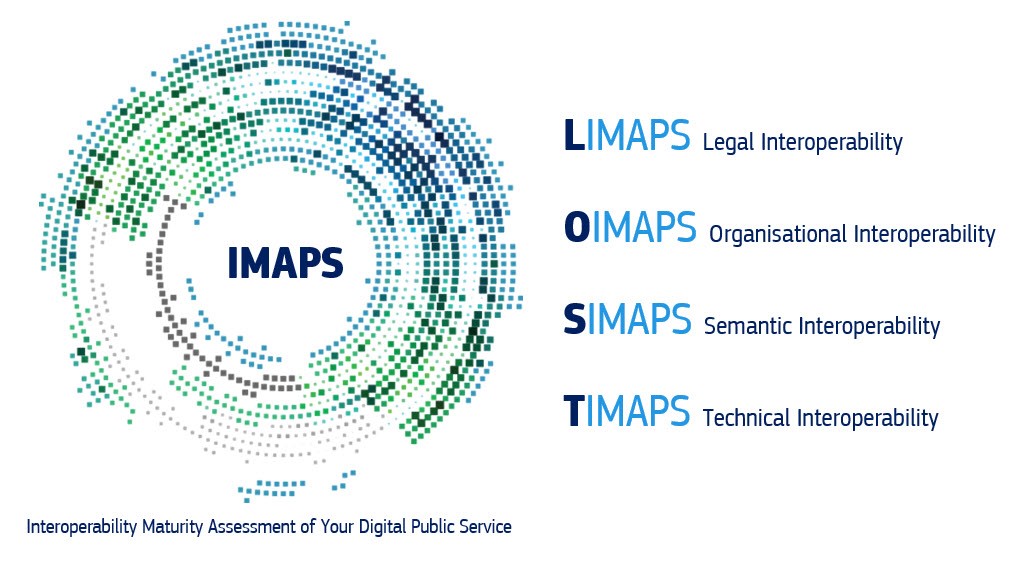Assessing the interoperability maturity of your digital public services

2016.37 Interoperability Maturity Assessment of a Public Service (IMAPS)
You are:
- An IT system architect or developer and want to design, develop and assess an interoperable IT architecture supporting a digital public service;
- An IT solutions portfolio manager and want to get insights for the governance of a portfolio of interoperable solutions for digital public services;
- A public procurement officer and want to identify standards and specifications for an interoperable digital public service
- A public service owner and want to diagnose the behavioural interoperability maturity level of a digital public service
- A policy-maker and want to identify the public services implementation orientation for the digitalisation of interoperable public services.
IMAPS and its legal, organisational, technical and semantic specialisations can help you in this task.
What is this action about?
The Digital Agenda for Europe has identified the lack of interoperability as a major obstacle for growth. More recently the Digital Single Market strategy has promoted interoperability and standards as important enablers for the Digital Single Market. Although EU Member States have accomplished significant work in this domain, it has proven difficult to assess the progress made so far by the different public administrations to reach higher levels of interoperability.
This action has developed IMAPS and its specialisations (LIMAPS, OIMAPS, TIMAPS, SIMAPS) to provide public administrations insight into their behavioural interoperability performance regarding:
- The current interoperability maturity level of their digital public service(s), considering key aspects of the behavioural legal, organisational, semantic and technical interoperability viewpoint;
- Improvement priorities to reach the next level of interoperability maturity.
IMAPS and its specialisations are designed as behavioural interoperability maturity assessment models, they are provided as self-assessment tools and they are realised via separate online surveys.
IMAPS can be used for a gap analysis assessing key behavioural interoperability aspects of a digital public service. Providing an overview of interoperability requirements and good practices, aligned with the European Interoperability Framework (EIF), it can guide public service owners in the development of digital public services, which are ‘interoperable by design’.
IMAPS helps public service owners to enhance the quality and customer focus of the delivery of the digital public service and facilitate collaboration between public administrations. Identifying opportunities for the sharing and reuse of available services and data, IMAPS supports public service owners to deliver their services in a more effective and efficient way.
Ultimately, end users of the digital public service, i.e. citizens, business, other public administrations, benefit from more interoperable services thanks to increased administrative efficiency and collaboration.
The predecessor of the IMAPS is the Interoperability Maturity Model (IMM).
What are the objectives?
- Devising a self-assessment tool to measure the behavioural interoperability maturity level of digital public services that can be consistently applied throughout the different European public administrations;
- Enabling Member States and EU institutions to assess the behavioural interoperability readiness of their digital public services, get recommendations on how to improve their interoperability and compare historically how interoperability of their services progresses;
- Analysing results, drafting conclusions for behavioural interoperability enablers, good practices and challenges in achieving high levels of interoperability maturity and identifying common patterns of recurring interoperability-related problems.
What are the benefits?
- Enabling Member States and EU institutions to assess their interoperability maturity against a common framework and identify current interoperability gaps in public service provision.
- Sharing interoperability good practices and promoting common standards and specifications for interoperable digital public services, aligned with the new European Interoperability Framework (EIF).
- Using the model as a guide to develop services interoperable by design, looking at the behavioural legal, organisational, semantic and technical requirements.
What has been achieved?
- More than 200 digital public services were assessed with IMAPS between 2018 and 2021;
- 51 benchmarked public services in 19 Member States in 2018 (see Report on IMAPS Results 2018 Edition);
- More than 27 Public administrations in the EU and beyond used IMAPS, at local, regional, national and international administrative levels.
- IMAPS knowledge transfer sessions organised with selected European public administrations, e.g. Belgium, Czech Republic, and Slovenia and Valencia
- Continuous improvement of IMAPS – updated version released in September 2021;
- Release of semantic, legal, organisational and technical specialisation of IMAPS (SIMAPS, LIMAPS, OIMAPS, TIMAPS) in September 2021;
- Release of semantic, legal, organisational and technical High Level Solution Architecture Templates (SIMAPS, LIMAPS, OIMAPS, TIMAPS HL SATs), as by-products of the respective IMAPS specialisations, illustrating the interoperability requirements required for a target digital public service;
- Design of the Single Interoperability Assessment Gateway, referencing all ISA2 interoperability assessment solutions, including IMAPS, and illustrating their benefits and use cases.
What are the next steps?
- Maintenance and further development of the IMAPS & its specialisations (SIMAPS, LIMAPS, OIMAPS, TIMAPS) and deployment at European public administrations;
- Maintenance and further development of the SIMAPS, LIMAPS, OIMAPS, TIMAPS HL SATs;
- Support to European public administrations in the uptake of IMAPS and its specialisations, in particular through the organisation of knowledge transfer sessions and support to capability-building activities;
- Promotion of new IMAPS user stories;
- Translation of IMAPS to facilitate the uptake of the solution, in particular by local public administrations;
- Continuous improvement of IMAPS and its specialisations by proactively collecting user feedback.

